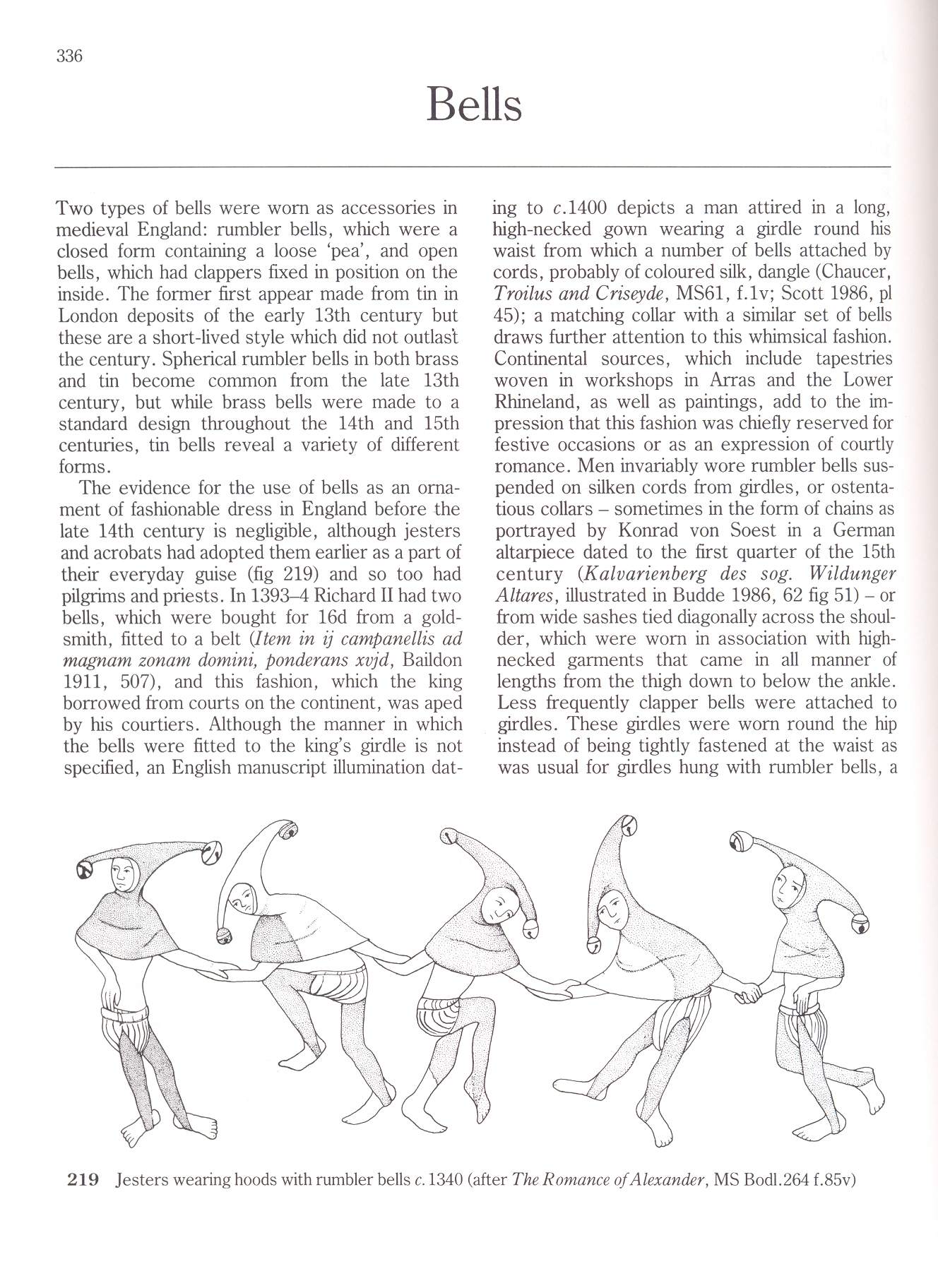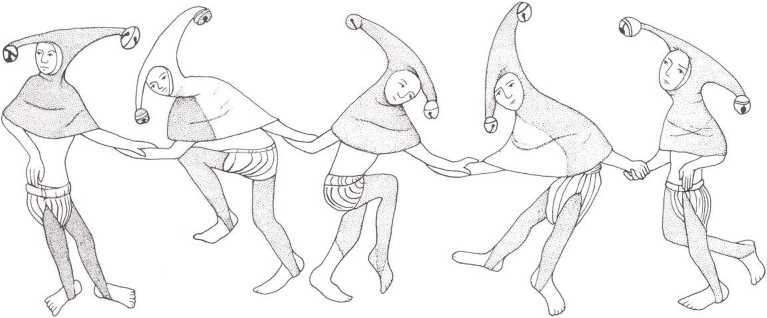363 (17)

336
Bells
Two types of bells were wom as accessories in medieval England: rumbler bells, which were a closed form containing a loose ‘pea’, and open bells, which had clappers fixed in position on the inside. The former first appear madę from tin in London deposits of the early 13th century but these are a short-lived style which did not outlas't the century. Spherical rumbler bells in both brass and tin become common from the late 13th century, but while brass bells were madę to a standard design throughout the 14th and 15th centuries, tin bells reveal a variety of different forms.
The evidence for the use of bells as an ornament of fashionable dress in England before the late 14th century is negligible, although jesters and acrobats had adopted them earlier as a part of their everyday guise (fig 219) and so too had pilgrims and priests. In 1393-4 Richard II had two bells, which were bought for 16d from a gold-smith, fitted to a belt iltem in ij campanellis ad magnam zonam domini, ponderans xvjd, Baildon 1911, 507), and this fashion, which the king borrowed from courts on the continent, was aped by his courtiers. Although the manner in which the bells were fitted to the king’s girdle is not specified, an English manuscript illumination dat-ing to c.1400 depicts a man attired in a long, high-necked gown wearing a girdle round his waist from which a number of bells attached by cords, probably of coloured silk, dangle (Chaucer, Troilus and Criseyde, MS61, f.lv; Scott 1986, pl 45); a matching collar with a similar set of bells draws further attention to this whimsical fashion. Continental sources, which include tapestries woven in workshops in Arras and the Lower Rhineland, as well as paintings, add to the im-pression that this fashion was chiefly reserved for festive occasions or as an expression of courtly romance. Men invariably wore rumbler bells sus-pended on silken cords from girdles, or ostenta-tious collars - sometimes in the form of chains as portrayed by Konrad von Soest in a German altarpiece dated to the first ąuarter of the 15th century (Kaharienberg des sog. Wildunger Altares, illustrated in Buddę 1986, 62 fig 51) - or from wide sashes tied diagonally across the shoul-der, which were wom in association with high-necked garments that came in all manner of lengths from the thigh down to below the ankle. Less freąuently clapper bells were attached to girdles. These girdles were wom round the hip instead of being tightly fastened at the waist as was usual for girdles hung with rumbler bells, a

219 Jesters wearing hoods with rumbler bells c. 1340 (after The Romance ofAlexander, MS Bodl.264 f.85v)
Wyszukiwarka
Podobne podstrony:
DSC04875 (c) Would you reject the nuli hypothesis that the mean satisfaction forthe two types of mon
sc insideatoms bmp ArOMS AND RADPOACT!VITYInside atoms 1 ~ i Charge essentials There are two types o
Data Expiry There are two types of data expiry within a memcached instance. The first type is applie
313 (31) 285 Lace Chapes Two forms of chape were defined at North-ampton (Oakley 1979, 262-63): Oakl
Weronika DZIKOWSKA determination of the two properties. Studies of the other two types of samples wi
111 HENDERSON B, 1976, Two types of film theory, in Movies and methods, Los Angeles, U.C.L.A. Bill N
A Cloud Computing M Cloud Computing - Introduction 4 Virtuakzation 4 3 Hyperytsors43 HYPERVISORSh Tw
80857 m1456 Two types of typical i5th century pole axe, as widely used by men-at-arms fighting on fo
62711 skanowanie0085 (2) There are two types of routines: 1. information routines - descriptions of
skanuj0002 Microeconomics Anna Blajer-Gołębiewska M. Sc.Exercise 8. Consumer purchases only two type
have all been found serviceable. AU types of adapt-alions can prove successful in fact, prnviding th
363
00270 d021c6388981baccfa088288e9ff089 272 Montgomery Choice of Factors and Levels As noted in Table
s&h 093 93 STHKNOTH ANI) HEALTH TIIK IINGKRS—No. 1 Plaee tlio palms of both hands tojiether, as slio
Cocordinates and notation again Wc considcr thc bchaviour of a transmission linc terminated as shown
Hauber, R. M., The Late LatinVoeabulary of the Moralia of St. Gregory Łhe Great (Studies in Medieval
więcej podobnych podstron